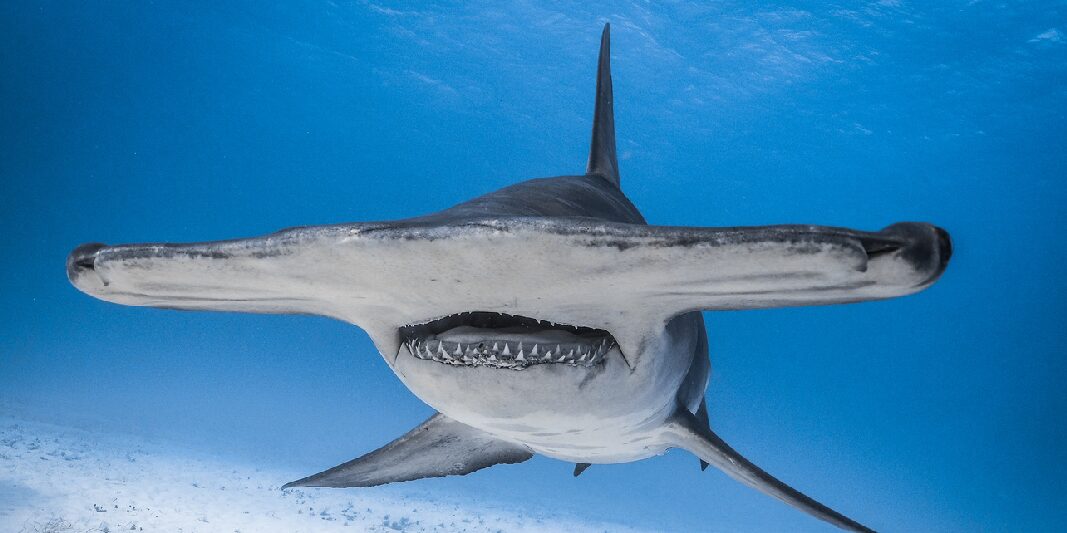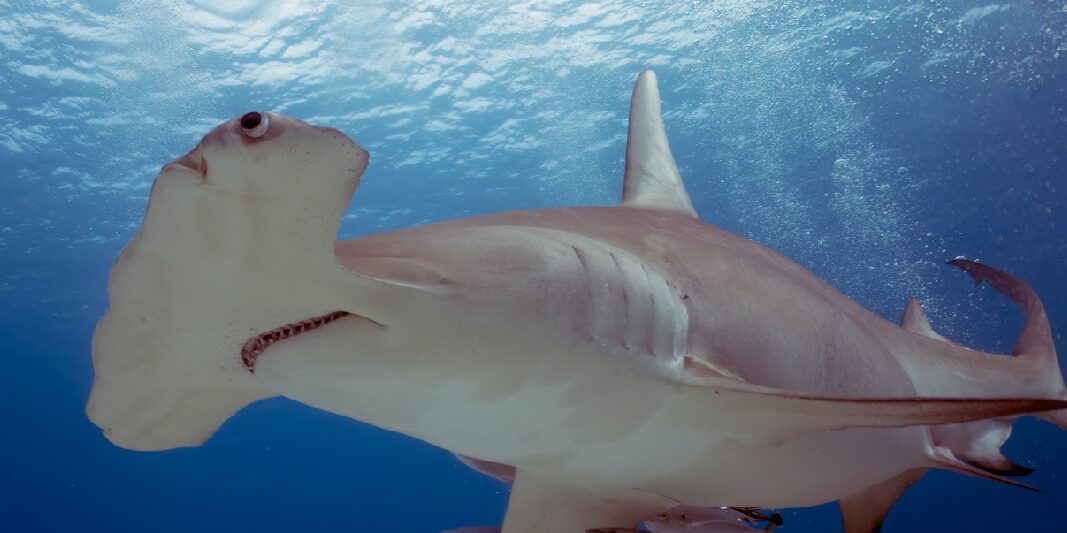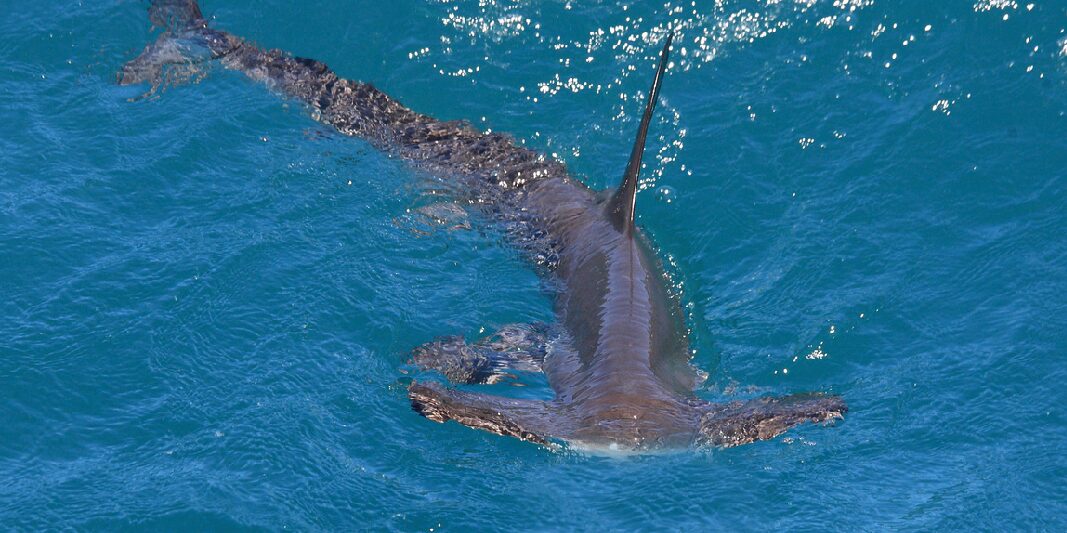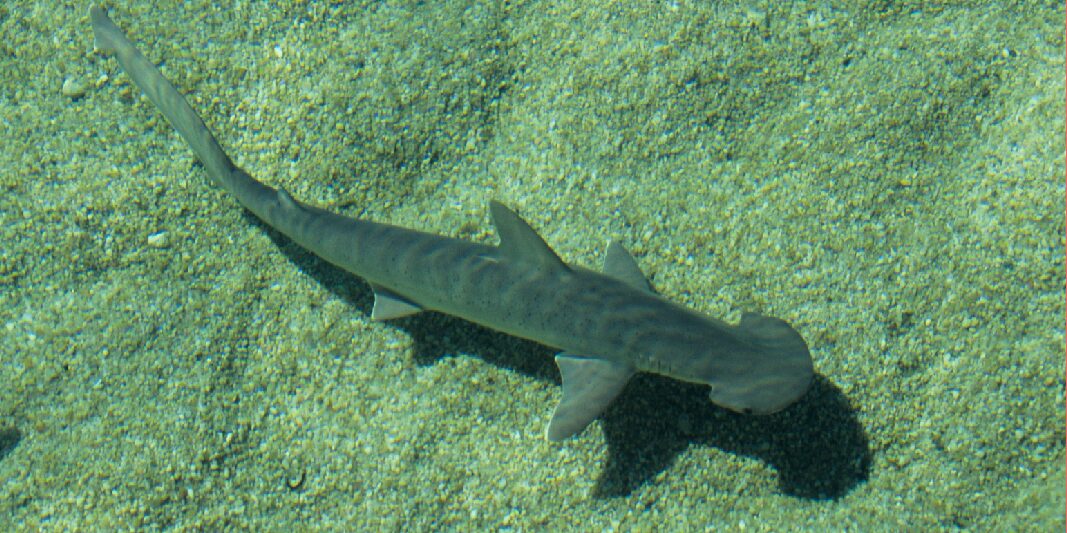
There’s something unforgettable about locking eyes with a hammerhead shark underwater. Their oddly shaped heads—called cephalofoils—give them one of the ocean’s most unique silhouettes. They’re visually striking, and play an important role in the health of marine ecosystems. Across the globe, there are ten recognized hammerhead species, and each one brings something unique to the underwater world.
Many divers dream of encountering a hammerhead, but do they know which of the ten they’re longing to see? In this guide, we’ll explore each species, where you can travel to dive with them, and more!

Great Hammerhead (Sphyrna mokarran)
The largest and most iconic of the hammerheads, the Great Hammerhead is typically a solitary shark that favors warm, tropical waters near coral reefs and continental shelves. It feeds on bony fish, squid, stingrays (a favorite), and even other sharks. Though shy by nature, it may approach divers out of curiosity—especially when hunting.
- Size: Up to 20 feet long and 1,000 pounds
- Conservation Status: Critically Endangered
- Dive Destinations: Bahamas, Galápagos, Costa Rica, Cocos Island

Scalloped Hammerhead (Sphyrna lewini)
This species is famous for schooling in large groups, particularly around cleaning stations. Found in warm coastal waters worldwide, it feeds on squid, fish, and octopus. While generally timid, the presence of other hammerheads in schools often increases diver visibility and encounters.
Scalloped Bonnethead (Sphyrna corona)
One of the smallest and rarest hammerhead species, this shark ranges from Mexico to Peru. It feeds on small fish and crustaceans and is rarely encountered due to its elusive behavior and limited range. Little is known about its habits, but it’s presumed to be reclusive and solitary.
- Size: Around 3 feet long
- Conservation Status: Critically Endangered
- Dive Destinations: Eastern Pacific (Mexico, Panama, Ecuador, Peru)
Winghead Shark (Eusphyra blochii)
The Winghead Shark is instantly recognizable due to its ultra-wide cephalofoil—nearly half its body length. It lives in shallow estuaries and coastal zones of the Indo-Pacific and feeds on crustaceans and small reef fish. These sharks are shy and typically hard to spot, often hugging mangrove-lined shores.

Smooth Hammerhead (Sphyrna zygaena)
Preferring cooler, temperate waters, the Smooth Hammerhead is highly migratory and feeds on a mix of rays, smaller sharks, and cephalopods. Unlike its tropical relatives, it’s more elusive and tends to avoid divers unless approached quietly.
- Size: Up to 13 feet long
- Conservation Status: Vulnerable
- Dive Destinations: New Zealand, South Africa, southern California, Canary Islands
Scoophead (Sphyrna media)
Inhabiting tropical coastal and mangrove ecosystems in South America, the Scoophead feeds on small reef fish and shrimp. It’s rarely seen, making it a holy grail sighting for shark lovers. Its slow, shy behavior keeps it mostly under the radar of divers.
- Size: Around 5 feet long
- Conservation Status: Critically Endangered
- Dive Destinations: Brazil, Colombia, Trinidad & Tobago
Smalleye Hammerhead (Sphyrna tudes)
This small species is sometimes called the “Golden Hammerhead” due to its distinctive golden sheen, which may come from its shrimp-based diet. It lives in shallow, murky coastal waters off South America and is highly cautious, often avoiding contact with divers.
- Size: Around 5 feet long
- Conservation Status: Critically Endangered
- Dive Destinations: Brazil, Venezuela, Guyana

Bonnethead (Sphyrna tiburo)
The Bonnethead is the only known omnivorous shark, feeding on seagrass along with crustaceans and small fish. Found in the western Atlantic and Caribbean, it is bold, fast-swimming, and often seen in small social groups. It’s one of the easiest hammerheads for beginner divers to observe.
- Size: Up to 4 feet long
- Conservation Status: Endangered
- Dive Destinations: Florida Keys, Bahamas, Gulf of Mexico
Whitefin Hammerhead (Sphyrna couardi)
This deep mystery of a shark resides mostly off the west coast of Africa. Scientists know little about its behavior, though it’s assumed to be benthopelagic, shy, and highly rare. It likely feeds on smaller fish and crustaceans.
- Size: Estimated up to 9 feet long
- Conservation Status: Data Deficient
- Dive Destinations: Senegal, Guinea, Mauritania (rare sightings)
Carolina Hammerhead (Sphyrna gilberti)
Discovered in 2013, the Carolina Hammerhead is almost identical to the Scalloped Hammerhead but has fewer vertebrae. It likely feeds on squid and fish and uses estuaries as nurseries. Much about its behavior remains unknown, but early research suggests it may be just as migratory and social as its look-alike cousin.
- Size: Up to 12 feet long
- Conservation Status: Likely Vulnerable or Critically Endangered
- Dive Destinations: South Carolina, Southeastern U.S. coast, possibly Brazil
Dive In—And Help Protect
Most hammerhead species are facing population declines due to overfishing, habitat destruction, and bycatch. Some, like the Great and Scalloped Hammerhead, are on the brink of extinction. Divers have a unique opportunity not only to witness these incredible animals in the wild but to advocate for their protection. Supporting marine sanctuaries, choosing eco-conscious dive operators, and spreading awareness are simple but powerful ways to help.
If you’re passionate about sharks, consider taking an SSI Shark Ecology or Marine Ecology Specialty Course to expand your understanding of these vital apex predators. By learning more about these amazing creatures—and choosing to dive responsibly—we can help ensure they’ll still be around for generations of divers to come. And if you dream of diving with them, check out Diventures’ upcoming trips to top shark destinations like the Galápagos, the Bahamas, and Costa Rica.















